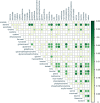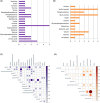Metabolite signature of human malignant thyroid tissue: A systematic review and meta-analysis
- PMID: 38646957
- PMCID: PMC11033922
- DOI: 10.1002/cam4.7184
Metabolite signature of human malignant thyroid tissue: A systematic review and meta-analysis
Abstract
Background: Thyroid cancer (TC) is the predominant malignancy within the endocrine system. However, the standard method for TC diagnosis lacks the capability to identify the pathological condition of all thyroid lesions. The metabolomics approach has the potential to manage this problem by identifying differential metabolites.
Aims: This study conducted a systematic review and meta-analysis of the NMR-based metabolomics studies in order to identify significant altered metabolites associated with TC.
Methods: A systematic search of published literature in any language in three databases including Embase, PubMed, and Scopus was conducted. Out of 353 primary articles, 12 studies met the criteria for inclusion in the systematic review. Among these, five reports belonging to three articles were eligible for meta-analysis. The correlation coefficient of the orthogonal partial least squares discriminant analysis, a popular model in the multivariate statistical analysis of metabolomic data, was chosen for meta-analysis. The altered metabolites were chosen based on the fact that they had been found in at least three studies.
Results: In total, 49 compounds were identified, 40 of which were metabolites. The increased metabolites in thyroid lesions compared normal samples included lactate, taurine, alanine, glutamic acid, glutamine, leucine, lysine, phenylalanine, serine, tyrosine, valine, choline, glycine, and isoleucine. Lipids were the decreased compounds in thyroid lesions. Lactate and alanine were increased in malignant versus benign thyroid lesions, while, myo-inositol, scyllo-inositol, citrate, choline, and phosphocholine were found to be decreased. The meta-analysis yielded significant results for three metabolites of lactate, alanine, and citrate in malignant versus benign specimens.
Discussion: In this study, we provided a concise summary of 12 included metabolomic studies, making it easier for future researchers to compare their results with the prior findings.
Conclusion: It appears that the field of TC metabolomics will experience notable advancement, leading to the discovery of trustworthy diagnostic and prognostic biomarkers.
Keywords: NMR; metabolomics; meta‐analysis; thyroid carcinoma; thyroid lesions.
© 2024 The Authors. Cancer Medicine published by John Wiley & Sons Ltd.
Conflict of interest statement
The authors have no conflict of interest.
Figures






Similar articles
-
Systemic pharmacological treatments for chronic plaque psoriasis: a network meta-analysis.Cochrane Database Syst Rev. 2021 Apr 19;4(4):CD011535. doi: 10.1002/14651858.CD011535.pub4. Cochrane Database Syst Rev. 2021. Update in: Cochrane Database Syst Rev. 2022 May 23;5:CD011535. doi: 10.1002/14651858.CD011535.pub5. PMID: 33871055 Free PMC article. Updated.
-
Signs and symptoms to determine if a patient presenting in primary care or hospital outpatient settings has COVID-19.Cochrane Database Syst Rev. 2022 May 20;5(5):CD013665. doi: 10.1002/14651858.CD013665.pub3. Cochrane Database Syst Rev. 2022. PMID: 35593186 Free PMC article.
-
Home treatment for mental health problems: a systematic review.Health Technol Assess. 2001;5(15):1-139. doi: 10.3310/hta5150. Health Technol Assess. 2001. PMID: 11532236
-
[Volume and health outcomes: evidence from systematic reviews and from evaluation of Italian hospital data].Epidemiol Prev. 2013 Mar-Jun;37(2-3 Suppl 2):1-100. Epidemiol Prev. 2013. PMID: 23851286 Italian.
-
Metabolomic profiling of upper GI malignancies in blood and tissue: a systematic review and meta-analysis.J Cancer Res Clin Oncol. 2024 Jul 1;150(7):331. doi: 10.1007/s00432-024-05857-5. J Cancer Res Clin Oncol. 2024. PMID: 38951269 Free PMC article.
Cited by
-
Emerging Potential of Metabolomics in Thyroid Cancer-A Comprehensive Review.Cancers (Basel). 2025 Mar 18;17(6):1017. doi: 10.3390/cancers17061017. Cancers (Basel). 2025. PMID: 40149351 Free PMC article. Review.
-
PeptiHub: a curated repository of precisely annotated cancer-related peptides with advanced utilities for peptide exploration and discovery.Database (Oxford). 2024 Sep 20;2024:baae092. doi: 10.1093/database/baae092. Database (Oxford). 2024. PMID: 39308247 Free PMC article.
References
Publication types
MeSH terms
Substances
LinkOut - more resources
Full Text Sources
Medical
Miscellaneous

